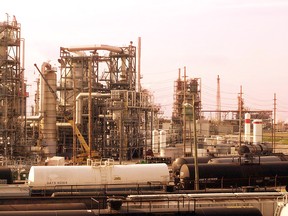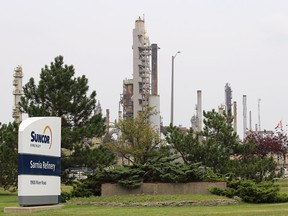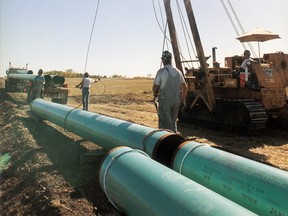Could it be done? Yes. Would it be a good idea? Probably not
Article content
As Canadian politicians try to come up with a response to Donald Trump’s tariff threat, a sticking point has emerged over a significant Canadian retaliatory option: limiting exports of Canadian oil and gas to the U.S.
Article content
Article content
The majority of Canada’s oil exports, largely produced in Alberta, go to the United States. And Alberta Premier Danielle Smith has flatly refused to entertain the option of cutting off that supply to American refineries if Trump slaps a 25-per-cent tariff on all Canadian goods, including gas and oil.
Advertisement 2
Article content
On Thursday, Trump upped the ante. Speaking at the World Economic Forum in Davos, Switzerland, the U.S. president said, “we don’t need their (Canada’s) oil and gas.”
“We have more than anybody,” he said.
In his inaugural address on Monday, Trump promised to “drill baby drill.”
There are two ways Canada could respond tit-for-tat on oil and gas. The first would be a full-on oil embargo against the United States. The second would be some sort of export tax.
But what if Canada did turn off the tap? What would it look like? Would such a move, as Smith and others have warned, also restrict supplies to Ontario and Quebec?
The National Post spoke with University of Alberta economist and law professor Andrew Leach, former Alberta energy minister Sonya Savage and former CEO of the now-defunct Canadian Energy Pipeline Association Chris Bloomer to get some answers.
First off, how much of Canada’s crude oil exports goes to the U.S.?
Ninety-seven per cent. So, a lot. Eighty-seven per cent of Alberta oil goes to the U.S.
All told, that’s around four million barrels per day, which is a significant percentage of daily American imports. The United States imports about 6.5 million barrels per day of crude oil.
Advertisement 3
Article content
Does the U.S. have enough oil to be able to refuse Canada’s?
Well, sort of. The U.S. does have a lot of oil. The catch is that the oil that comes from Canada is different from the oil that the United States produces domestically. That means that many refineries in the United States, particularly in the Midwest and around the Gulf Coast, are set up to process Canadian crude.
Even if the U.S. energy sector could ramp up production it wouldn’t solve the problem for those refineries, because they’re not configured to take the type of oil that’s produced in the U.S., said Savage.
Additionally, some of the pipelines run north to south, feeding American refineries with Canadian oil. They would need to be reversed, said Savage, and perhaps run heavy crude from Venezuela or Saudi Arabia from tankers docking on the Gulf Coast.
The refineries on the West Coast would have to source it from South America or perhaps Iraq instead of Canada, Savage said.

How many pipelines are there between Canada and the United States?
Lots. The big one is Enbridge’s Mainline network, comprised of several pipelines that run from Edmonton, Alta., to southern Manitoba. There it connects with the U.S. Lakehead system before carrying on back into Canada via Line 5 and on to Montreal via Line 9.
Article content
Advertisement 4
Article content
The original Keystone pipeline runs from Hardisty, Alta., to southern Manitoba, where it crosses the border. It carries about 14 per cent of western Canadian crude oil to U.S. refineries.
The Trans Mountain pipeline runs to Burnaby, B.C., and supplies oil to refineries in California and Washington.
The Express pipeline goes directly south from Hardisty to Wild Horse, Alta. There are several others, including the Aurora and Milk River pipeline, that are not massively long but integrate the Canadian network with the American network.
Who regulates pipelines?
Pipelines that cross provincial borders or international borders are governed by the Canada Energy Regulator — that accounts for the vast majority of Canadian pipelines. Those within a province are regulated provincially.
Given that, the federal government could presumably order pipelines to shut down?
First off, yes, pipelines can be shut down, strictly from a technical standpoint. It happens most obviously in the case of spills, when the oil flow upstream needs to be shut down. This does have a cascading series of effects, however. Oil needs to be reversed out of the pipeline and then perhaps into tank farms to hold it.
Advertisement 5
Article content
Could the federal government order a shutdown? The hunch among experts seems to be yes, perhaps via legislation in Parliament or a cabinet order. Pipelines require an export permit from the Canada Energy Regulator, said Savage, which could in theory be revoked.
(None of that deals with the other question here, which is whether that would be a good idea in the first place, and some have argued that it’s not.)
But if it happens, what would it look like?
This is maybe where things get complicated, not just from the standpoint of having to find a place to hold all that oil while things aren’t flowing, although that would be a big deal.
“You’re talking about a massive quantity of oil and you’re talking about limited storage at different points, and so at some point then, production either gets curtailed on this side of the border — like we just don’t have enough storage to not ship to the U.S. So you’re backing up into our production, you’re moving crude onto rail to wherever, but there’s just nowhere to go,” said Leach.
But there would be a pile of contractual issues. The way pipelines work is that a refinery in the U.S., for example, buys a batch of oil and pays for it to be shipped through the pipeline. Any shutdown would lead to a contractual battle, almost certainly. Indeed, that batch of oil purchased by refinery X might be parcelled off and sold even while it’s in transit, so there would be a cascade of contractual issues.
Advertisement 6
Article content
“It would be horrendous,” said Bloomer. “It creates commercial chaos that’s going to (have) major ripple effects.”
There may be, Savage said, some sort of force majeure clause in those contracts that would indemnify Canadian companies because of government action.
The other issue — and this has been central to the argument that some politicians have been making — is that if you shut off oil going into the United States, you also shut off the flow that heads back into Canada.

Why does that matter?
If you were to stop all flow through Enbridge’s Mainline system you would empty Line 5 that’s taking oil to 10 refineries in the Sarnia, Ont., region and Line 9 that takes oil to Montreal.
It might be possible to cut off the flow to the U.S. while still maintaining the flow back to Canada, but then the U.S. government could simply do the same thing and plug their sections of pipe, cutting off the flow back to Ontario and Quebec.
“I can’t imagine that Trump would allow, if we had an oil embargo, that Trump would allow any oil out of the United States going into Canada,” said Savage.
What would it do to U.S. refineries?
Advertisement 7
Article content
Simply put, they’d run out of the oil needed to run refineries and this would increase costs as they sourced new supply. There would also be a longer-term cost associated with retrofitting crude-oil refineries to process lighter American oil or reversing pipelines.
This would, in turn, devastate the Canadian oil industry. If the U.S. really stopped needing our oil, then the export markets — remember, 97 per cent of our crude oil goes south — would dry up.
“You’d see production shut in because we don’t have places to store it,” said Savage. “You’d see unemployment surge. You’d see like foreclosures again. You’d see the kind of destruction out of the NEP (National Energy Program), and it would be extremely hard to recover.”
What about an export tax or something like that?
It would increase costs for everybody. This, in turn, could cause production to stall or drop off, leading to layoffs and a decline in royalty revenues in Alberta. South of the border, it would increase costs, potentially beginning the same series of effects — increased gasoline prices, the hunt for new oil sources — that an export ban would lead to.
Advertisement 8
Article content
Alberta could order production curtailment — it’s been done before — to try to reduce supply to boost price, which in turn squeezes the Americans. But it reduces royalty revenues and would certainly have some financial consequences in Canada, too.
So in the end, bad news?
“It’s corporate profits, it’s taxes, it’s royalties, and then there’s huge consequences on the other side of the border and potentially in southern Ontario, depending on what happens, where you end up with substantial, in very short order, shortages of gasoline, diesel, jet fuel,” said Leach.
It would also hurt Americans. And so, at some point, if the Americans impose a tariff, we could potentially do nothing and just let them hurt for a bit.
“It’s going to be very painful, but it will self correct, because the damage to the United States is going to be severe,” said Savage. “So I think it’ll self correct. I don’t know how long it would take to self correct, and it could be painful, but it will self correct.”
Recommended from Editorial
Our website is the place for the latest breaking news, exclusive scoops, longreads and provocative commentary. Please bookmark nationalpost.com and sign up for our newsletters here.
Article content








